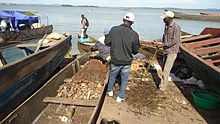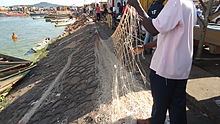This article needs additional citations for verification. (July 2015) |





There are two major sources of fish in Uganda; one is from aquaculture, the other from fishing in rivers and lakes. The latter has made up the largest and most significant share of all fishing. Open water covers 15.3 percent of Uganda's surface and comprises five major lakes (Lake Victoria, Lake Albert (Africa), Lake Kyoga, Lake Edward and Lake George (Uganda)) which are the main sources of fish in the country. Lake Victoria continues to be the most important water body in Uganda both in size and contribution to the total fish catch, followed by Lake Albert and Lake Kyoga.[1]
Uganda's main sources of fish supply for both the domestic and export markets are the districts on Lake Victoria, particularly Mukono, Mpigi, Kalangala, Masaka and Luwero. Lake Kyoga, Albert, George and Edward districts are other major sources of fish. The major urban centres within the Lake Victoria belt, namely Kampala, Masaka, Jinja and Entebbe constitute the main domestic market centres for fresh fish. Although considerable fish supplies reach these market nuclei and most of the other district headquarters markets, inadequate supplies reach most of the rural markets.[2]
Primary production of fish is generally done on a relatively small-scale, as most of the fishing is carried out using small, wooden (plank-built) boats about six to eight meters in length propelled by oars or, in an increasing number of cases, a petrol engine fastened to the back of the boat. These simple boats are sufficient to carry fishermen to and from the fishing grounds with full loads of fish.[3]
- ^ "2013 Statistical Abstract" Archived 2014-11-13 at the Wayback Machine ubos.org.Retrieved on October 29, 2014.
- ^ "Towards an Appropiate [sic] Management Regime for the Fisheries Resources of Uganda/" unuftp.is. Retrieved on October 29, 2014.
- ^ "The political economy of the fisheries sector in Uganda: ruling elites, implementation costs and industry interests" Archived 2014-10-30 at the Wayback Machine subweb.diis.dk.Retrieved on October 30, 2014.